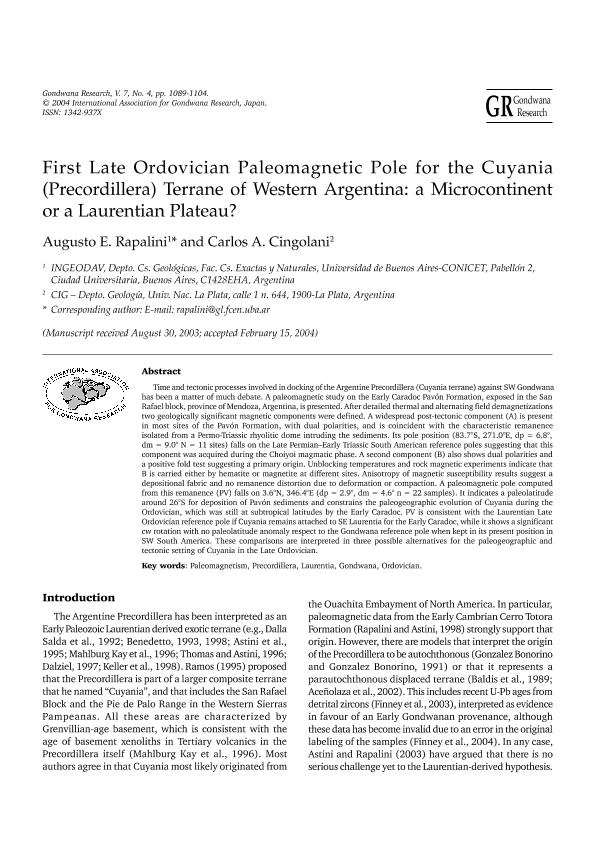Mostrar el registro sencillo del ítem
dc.contributor.author
Rapalini, Augusto Ernesto

dc.contributor.author
Cingolani, Carlos Alberto

dc.date.available
2019-04-26T18:24:35Z
dc.date.issued
2004-12
dc.identifier.citation
Rapalini, Augusto Ernesto; Cingolani, Carlos Alberto; First late Ordovician paleomagnetic pole for the Cuyania (Precordillera) terrane of western Argentina: A microcontinent or a Laurentian plateau?; Elsevier Science; Gondwana Research; 7; 4; 12-2004; 1089-1104
dc.identifier.issn
1342-937X
dc.identifier.uri
http://hdl.handle.net/11336/75132
dc.description.abstract
Time and tectonic processes involved in docking of the Argentine Precordillera. (Cuyania terrane) against SW Gondwana has been a matter of much debate. A paleomagnetic study on the Early Caradoc Pavón Formation, exposed in the San Rafael block, province of Mendoza, Argentina, is presented. After detailed thermal and alternating field demagnetizations two geologically significant magnetic components were defined. A widespread post-tectonic component (A) is present in most sites of the Pavón Formation, with dual polarities, and is coincident with the characteristic remanence isolated from a Permo-Triassic rhyolitic dome intruding the sediments. Its pole position (83.7°S, 271.0°E, dp = 6.8°, dm = 9.0° N = 11 sites) falls on the Late Permian-Early Triassic South American reference poles suggesting that this component was acquired during the Choiyoi magmatic phase. A second component (B) also shows dual polarities and a positive fold test suggesting a primary origin. Unblocking temperatures and rock magnetic experiments indicate that B is carried either by hematite or magnetite at different sites. Anisotropy of magnetic susceptibility results suggest a depositional fabric and no remanence distortion due to deformation or compaction. A paleomagnetic pole computed from this remanence (PV) falls on 3.6°N, 346.4°E (dp = 2.9°, dm = 4.6° n = 22 samples). It indicates a paleolatitude around 26°S for deposition of Pavón sediments and constrains the paleogeographic evolution of Cuyania during the Ordovician, which was still at subtropical latitudes by the Early Caradoc. PV is consistent with the Laurentian Late Ordovician reference pole if Cuyania remains attached to SE Laurentia for the Early Caradoc, while it shows a significant cw rotation with no paleolatitude anomaly respect to the Gondwana reference pole when kept in its present position in SW South America. These comparisons are interpreted in three possible alternatives for the paleogeographic and tectonic setting of Cuyania in the Late Ordovician.
dc.format
application/pdf
dc.language.iso
eng
dc.publisher
Elsevier Science

dc.rights
info:eu-repo/semantics/openAccess
dc.rights.uri
https://creativecommons.org/licenses/by-nc-nd/2.5/ar/
dc.subject
Gondwana
dc.subject
Laurentia
dc.subject
Ordovician
dc.subject
Paleomagnetism
dc.subject
Precordillera
dc.subject.classification
Geoquímica y Geofísica

dc.subject.classification
Ciencias de la Tierra y relacionadas con el Medio Ambiente

dc.subject.classification
CIENCIAS NATURALES Y EXACTAS

dc.title
First late Ordovician paleomagnetic pole for the Cuyania (Precordillera) terrane of western Argentina: A microcontinent or a Laurentian plateau?
dc.type
info:eu-repo/semantics/article
dc.type
info:ar-repo/semantics/artículo
dc.type
info:eu-repo/semantics/publishedVersion
dc.date.updated
2019-04-23T14:40:39Z
dc.journal.volume
7
dc.journal.number
4
dc.journal.pagination
1089-1104
dc.journal.pais
Países Bajos

dc.journal.ciudad
Amsterdam
dc.description.fil
Fil: Rapalini, Augusto Ernesto. Universidad de Buenos Aires. Facultad de Ciencias Exactas y Naturales. Departamento de Geología. Instituto de Geofísica "Daniel Valencio"; Argentina. Consejo Nacional de Investigaciones Científicas y Técnicas; Argentina
dc.description.fil
Fil: Cingolani, Carlos Alberto. Consejo Nacional de Investigaciones Científicas y Técnicas. Centro Científico Tecnológico Conicet - La Plata. Centro de Investigaciones Geológicas. Universidad Nacional de La Plata. Facultad de Ciencias Naturales y Museo. Centro de Investigaciones Geológicas; Argentina
dc.journal.title
Gondwana Research

dc.relation.alternativeid
info:eu-repo/semantics/altIdentifier/url/https://www.sciencedirect.com/science/article/pii/S1342937X05710868
dc.relation.alternativeid
info:eu-repo/semantics/altIdentifier/doi/http://dx.doi.org/10.1016/S1342-937X(05)71086-8
Archivos asociados
